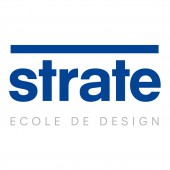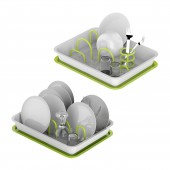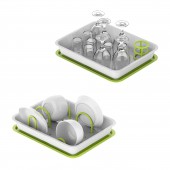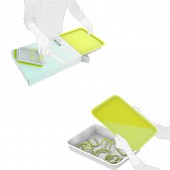DESIGN NAME:
Dish Plug
PRIMARY FUNCTION:
Dish Rack
INSPIRATION:
A typical dishrack is designed to allow dishware to sit vertically to drain off excess water. However, deep plates, rice bowl or bowls, have to be stacked because of the width between the partitions of the dishrack is too narrow. This creates an un-sanitary drying condition because the water between the stacked dishes pools from lack of ventilation. My aim was to allow for all dishes to sit vertically allowing for natural airflow and easy drainage.
UNIQUE PROPERTIES / PROJECT DESCRIPTION:
Dishes and bowls can only be stacked after washing because the existing dishrack have fixed width partitions. This dishrack concept allows users to customize the partition, allowing a variety of different dishes to sit vertically and drain.
OPERATION / FLOW / INTERACTION:
Users can install U-shape partitions directly onto the dishrack. Depending on the depth of the bowl, the user can adjust the width of the partitions, allowing any dish to drain vertically. The dishrack has holes in the bottom, which allows water to drain out.
PROJECT DURATION AND LOCATION:
The project started in Mars 2016 in Paris and finished in November 2016 in Seoul, and was exhibited in Canton fair in October 2016.
FITS BEST INTO CATEGORY:
Furniture Design
|
PRODUCTION / REALIZATION TECHNOLOGY:
The dishrack body and the lid are made from plastic injection molding.
SPECIFICATIONS / TECHNICAL PROPERTIES:
450 mm x 350 mm x 71.50 mm
TAGS:
Kitchenware, Kitchen Gadget, Kitchen Utensil, Dish Rack, Dish Drainer, Customizable
RESEARCH ABSTRACT:
The ideal size was found by measuring existing plate, dishrack and sink dimensions. I had a variety of friends test the initial prototype asking them to make a list of positive and negative. Taking their feedback I modified the design to attend the Korea StartUp Design Award so that I could get experts’ feedback. With the advice I received, I continued refine the prototype in order to enter the Canton Fair in China. There I received practical advice from buyers from all over the world.
CHALLENGE:
Finding the right gap between the partition insert holes was the most difficult. If the gaps between the holes are narrow, deep plates were prevented from entering between the partitions, and vice versa, when the gap between holes is wide, most of the plates were laid down.
ADDED DATE:
2018-06-30 12:20:52
TEAM MEMBERS (1) :
IMAGE CREDITS:
Image #1: Photographer Jisu MUN/Jisu MUN/Jisu MUN
Image #2: Photographer Jisu MUN/Jisu MUN/Jisu MUN
Image #3: Photographer Jisu MUN/Jisu MUN/Jisu MUN
Image #4: Photographer Jisu MUN/Jisu MUN/Jisu MUN
Image #5: Photographer Jisu MUN/Jisu MUN/Jisu MUN
|









